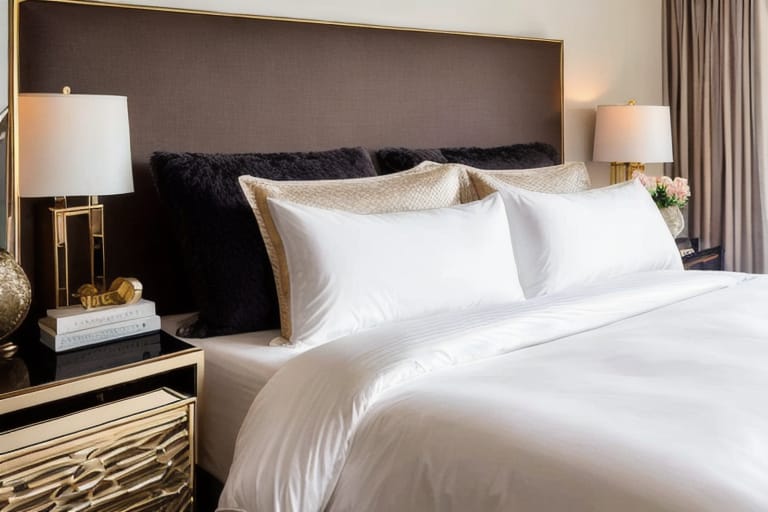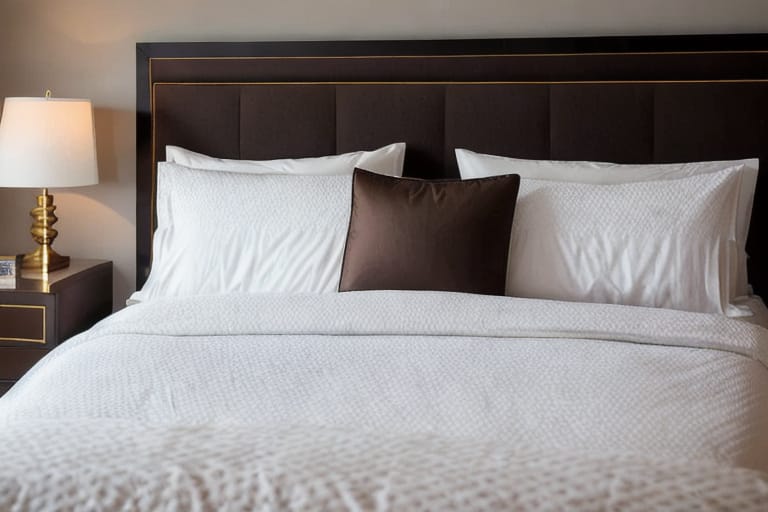When it comes to bedding, down comforters stand out as a luxurious and warm option. But with the high price tag, are these puffy duvets worth it?
This beginner’s guide on down comforters covers everything you need to know, from types of down fill and construction quality to maintenance, pros and cons, and alternatives. Read on to find out if investing in one of these cozy comforter sets makes sense for your bedroom.
What Is a Down Comforter?
A down comforter is a type of duvet insert filled with the fine, fluffy underside feathers from ducks or geese. This natural down filling provides unmatched warmth and insulation for the ultimate in cozy comfort.
Down comforters are known for:
- Exceptional warmth without weight
- Soft, pillowy texture
- Luxurious comfort and coziness
- Long durability with proper care
Unlike regular blankets or quilts, down comforters are designed to be used inside a duvet cover rather than on their own. The duvet cover protects the down while allowing air to circulate and provide insulation.
A Brief History of Down Bedding
Down filled bedding dates back centuries, originating in Europe where frigid winters drove a need for ultra warm covers. Goose and duck down provided superior insulation compared to materials like wool or cotton.
While stuffed-down bedding existed in antiquity, the basic concept of baffled channels filled with down emerged in the late 1800s. Advances in textile manufacturing allowed down comforters to become widely available consumer products by the mid-1900s.
Today, down comforters combine cutting edge designs with premium materials to create the peak of bedroom luxury and comfort.
Why Quality Bedding Matters for Sleep
Investing in a quality down comforter makes sense when you consider how critical the sleep environment is for health and wellbeing. As you spend about a third of your life asleep, choosing bedding that optimizes comfort, support, and temperature can pay dividends.
The right bedding leads to:
- Deeper, more restorative sleep
- Reduced tossing and turning
- Enhanced relaxation
- Improved mood and focus
Conversely, low-quality bedding that lacks features like moisture wicking, breathability, and adjustability can severely impact sleep satisfaction and quality.
Types of Down Comforters and Bedding
Fill Power
The most important measurement for down quality is fill power. This indicates the loft or fluffiness of the down, which directly relates to its warmth and lasting power.
Higher fill powers trap more air and provide better insulation. But they usually come with a higher price tag.
- 400-550 fill power – Entry level. Less fluffy but affordable option.
- 600-650 fill power – Mid range. Balance of quality and price.
- 700-900+ fill power – Premium. Investment pieces with exceptional loft and durability.
Construction
Down comforters feature baffle box construction that consists of fabric walls dividing the comforter into sections. These baffles prevent the delicate down from shifting or clumping on one side.
Higher-end down comforters boast finer denier fabric, more baffle boxes, and reinforced stitching for durability. Features like corner loops to attach to duvets and layered construction add quality touches.
Top Benefits of Down Comforters
Incredible Warmth and Temperature Regulation
The unbeatable warmth Down provides comes from its unmatched insulation properties. The fluffy filaments trap air and body heat next to your skin, unlike any other fill. Even lightweight down keeps you toasty without bulk.
Down also offers excellent breathability due to its natural moisture wicking abilities. This temperature regulation prevents you from overheating while maintaining a comfortable microclimate. The result is the perfect sleeping temperature all night long.
Luxurious Softness and Coziness
Slipping under a down comforter envelopes you in plush softness. The feathery light fill perfectly drapes over your body without pressure points for sublime, cloud-like comfort.
The sensation of luxury and coziness down provides not only feels decadent but also creates a soothing, welcoming environment that relaxes both mind and body before sleep.
Long-Lasting Durability and Performance
With proper care, quality down comforters can last over 10 years or longer before needing replacement. The natural fill stays lofty and insulating over time rather than flattening out like synthetic options.
Higher fill powers above 600 offer especially enduring performance and retain warmth even after years of washing. This makes down a wise investment for long-term use.
Considerations Before Buying
While purchasing a down comforter may seem as simple as picking a size, taking a few factors into account ensures you select the optimal choice.
Maintenance and Care Needs
To safeguard your investment and keep down performing at its best, proper maintenance is essential. Here are the top care tips:
- Only wash when truly dirt. Spot clean when possible
- Use a front-loading washer on a delicate cycle
- Add 2-3 tennis balls to dryer to re-fluff
- Never iron or bleach
- Store folded or hung to preserve loft
Improper washing can strip natural oils and damage down. Following guidelines keeps your comforter clean and puffy for the long run.
Allergies and Finding Hypoallergenic Options
Down itself is hypoallergenic, meaning it won’t trigger allergies or asthma symptoms. But lower quality down containing feathers or dust can cause issues for sensitive sleepers.
Seeking out hypoallergenic certified wash processed down guarantees every last bit of dander and debris gets removed. This opens up down’s benefits even if you typically react to bedding.
Pairing a down comforter with an allergen blocking duvet adds further protection.
Costs and the Value Proposition
There’s no denying down comforters carry a heftier price tag than polyester alternatives. But the unbeatable warmth, softness, and longevity down delivers offers outstanding value in the long run.
Higher fill power down that keeps insulating after years of use means you won’t need frequent replacing. This saves money compared with low price bedding that loses oomph quickly.
Viewing a down comforter as a 10+ year investment up front makes the splurge worthwhile. Just ensure you choose an ethically sourced brand that takes sustainability seriously.

How Do Down Comforters Compare to Alternatives?
While Down stands apart for its stellar combination of lightweight warmth, softness, and durability, other bedding fills have their own pros and cons to consider.
Synthetic Duvet Inserts
Polyester and other synthetic fills offer budget friendly options starting under $100. But they lack down’s coveted cloud-like comfort and easily lose loft. Their lifespan maxes out at 2-5 years with regular use.
If staying under budget is priority number one, synthetic comforters work in a pinch. Just prepare for somewhat flat, inferior warmth long term.
Good for: Very low budgets
Feather Filled Comforters
True to the name, feather beds contain plumage from ducks or geese for fill rather than down specifically. The fill consists of feather shafts rather than delicate clusters.
Feather comforters mimic down’s enveloping comfort at a lower price point. However the fill requires more frequent fluffing to prevent flat spots. Feathers also lack Down’s unmatched lightweight insulation.
Good for: Budget-conscious shoppers who still want a natural fill
Wool, Cotton, and Other Materials
Natural fibers like merino wool or long-staple cotton work well for traditional quilts and blankets. But they can’t match Down’s combination of softness, insulation, and durability when used as a duvet insert.
If you love natural materials, layering wool or cotton blankets under or over a down comforter offers the best sleeping experience. This optimizes breathability and comfort.
Good for: Layering and customizing bedding
| Fill Material | Price | Warmth | Softness | Durability |
|---|---|---|---|---|
| Down | $$$$ | ⭐⭐⭐⭐⭐ | ⭐⭐⭐⭐⭐ | ⭐⭐⭐⭐ |
| Synthetic | $ | ⭐⭐ | ⭐⭐ | ⭐ |
| Feather | $$ | ⭐⭐⭐ | ⭐⭐⭐ | ⭐⭐ |
| Wool | $$ | ⭐⭐ | ⭐⭐⭐⭐ | ⭐⭐⭐ |
| Cotton | $ | ⭐⭐ | ⭐⭐⭐⭐⭐ | ⭐⭐ |
Table 1. Comparison chart of down vs other common comforter fills.
More Than Just the Comforter: Optimizing Your Sleep Environment
While a down comforter offers exceptional comfort and temperature regulation, other bedrooms and seasonal factors impact sleep as well. Don’t overlook these elements when designing your ideal snoozing sanctuary.
Bedding Layers
Layer bedding underneath your down comforter to let you customize warmth and softness precisely for your needs. Adding a blanket or light quilt below allows you to adjust the insulation so you never overheat or chill.
Mattress and Pillows
All the blankets in the world won’t help if your mattress causes soreness or fails to support. Research suggests replacing mattresses at least every 8-10 years. Find ones offering customization like adjustable firmness and temperature regulation.
Likewise, pillows should keep your head and neck aligned with shoulders relaxed all night. Down and memory foam offer plush options.
Ambient Temperature and Humidity
Ideally, bedrooms should stay around 60-67°F (15- 20°C) and 40-50% humidity for optimal sleep. This balance prevents overheating without allowing sinus-drying aridity.
Use a humidifier in dry winter months and fans to circulate air during summer. Smart climate control devices let you customize schedules and settings. Open windows regularly for fresh air.
Bedroom Design and Decor
Curating a relaxing, inviting sleep sanctuary sets the stage for deep rest. Details like soft lighting, calming artwork, plants, soothing paint colors and a minimalist organization promote relaxation.
Save stimulating electronics and clutter for other living spaces to prevent mental stimulation before bed.
Making an Informed Down Comforter Purchase
Ready to start shopping? Follow this advice for finding the perfect down comforter.
Research Brands and Read Reviews
With many bedding brands available, reading buyer experiences helps discern quality products from duds. Seek out brands specializing in down with transparent ethical sourcing.
Dig into reviews checking for notes on durability, warmth, and puffiness over time. Pay attention to customer service feedback as well to ensure satisfactory support.
Understand Return Policies and Warranties
Buying a down comforter sight unseen calls for a sound return policy just in case the pick doesn’t live up to expectations once it arrives.
Seek out retailers with 60-day or longer trial periods. Be sure to abide by any care instructions during your testing phase.
For longest-lasting peace of mind, choose brands offering 10+ year or lifetime warranties as well.
Take Size, Fabric, and Design into Account Too
Beyond fill power, tailor your selection by:
- Size – Twin to California King
- Shell fabric – cotton, microfiber, sateen
- Color/patterns – Solid, print, or reversible
- Stitches per inch
- Design touches like corner loops
This customization ensures both technical performance and the style you love.
Caring for your Down Comforter
To keep your down comforter in peak, fluffy condition:
Cleaning
- Spot clean mild stains immediately using distilled water and mild detergent
- Machine or dry clean every 2-5 years depending on use
- Use oversized home washers for at-home cleaning to allow movement
- Air or tumble dry with 2-3 clean tennis balls
Storage
- Store in breathable, oversized cotton bags
- Avoid overly compressing
- Refluff and redistribute down every 6 months
Preventing Damage
- Keep pets and sharp objects away
- Avoid direct sunlight exposure
- Use duvet cover for protection
With proper maintenance, your investment will pay dividends for over a decade of blissful comfort.
Troubleshooting Down Comforter Issues
While down comforters boast exceptional durability, you may encounter a few snags. Here are fixes for the most common problems.
Flat Spots
Down needs regular fluffing to prevent compacting into flat, ineffective clumps. Every few months, manually work down into corners and edges for even distribution. Throw in the dryer with tennis balls to fluff the whole comforter.
Odor Buildup
Musty or sour smells come from moisture buildup over time. Air out the comforter then dry clean to eliminate odors. Always fully dry after washing and store in breathable conditions.
Allergies
If allergies develop, first switch detergent and wash thoroughly since debris triggers reactions. Bathing a dog that sleeps in bed also helps. If issues persist, choose a hyper-allergenic down option specifically purified to remove proteins.
Fact-Checking Down Comforter Beliefs and Myths
Before deciding if a down comforter belongs in your bedroom, let’s separate myths from reality on these puffy duvets.
Myth: Natural down has superior warmth
Fact: Both down and high-quality synthetic fills provide excellent warmth, with inexpensive polyester being the outlier.
Myth: Feathers and down are the same Fact: Feathers come from quill shafts, while down clusters grow underneath feathers near bird skin for insulation.
Myth: Down requires special dry cleaning Fact: Front loading home washing machines clean down well with mild detergent and tennis balls to dry. Dry clean only if truly soiled.
Myth: Anyone can use down Fact: People with severe allergies may still react to proteins in down. Choosing hyper-allergenic wash processed down reduces risks for sensitive sleepers.
While Down has earned its luxurious reputation after centuries of use, synthetic tech has closed the gap regarding warmth — though not yet for matchless softness. Proper selection allows almost anyone, even allergy sufferers, to enjoy down.
Down Production and Sourcing Controversies
With stock limited by the supply of geese and ducks, some down sourcing and production raises environmental and ethical concerns.
Live Plucking
Some suppliers in China and Eastern Europe reportedly live to pluck birds rather than gathering usable down solely from natural molting. This inhumane practice causes injuries and pain. Conscientious brands ensure their supply chains only use humanely sourced down certified by industry organizations like the Responsible Down Standard (RDS).
Sustainability Issues
Down production places strain on land resources for raising waterfowl. And washing processes require copious H20 which strains local water supplies without careful management. Top brands monitor and optimise their processes to reuse water, lower chemical use, and upcycle materials for improved sustainability.
For eco-conscious shoppers, looking for certifications like the Global Recycled Standard (GRS) ensure products use reclaimed materials in construction.

Incorporating Down Comforters Into Your Bedroom Decor
Beyond keeping you cozy while sleeping, down comforters also influence the aesthetics and style of your sleep sanctuary. Follow these interior design tips for an eye-pleasing bedroom showcase.
Choose Colors and Patterns That Relax
While vibrant down colors and prints look gorgeous in the right bedroom style, it’s wise to avoid overly stimulating patterns in your main oasis for rest.
Stick to solid neutrals, or muted tones like sage green, slate blue, and gentle stripes for a soothing backdrop as you drift off. Save the bold geometrics and florals for living spaces.
Mix Textures with Layers and Accessories
Creating an ultra welcoming nest starts with mixing plush and crisp textures. An organic cotton duvet cover adds breathable crispness over the down insert’s marshmallowy softness. Accent with nubby knit blankets and smooth silk sheets.
Frequently Asked Questions about Down Comforters
Is a down comforter warmer than a quilt or blanket?
Yes, down comforters provide unmatched warmth and insulation. The fluffy fill traps air extremely efficiently to retain body heat better than any other material. So you stay blissfully warm without the weight of bulky blankets.
How do I wash a down comforter at home?
Use a front loading washing machine, mild detergent, and the delicate or handwash cycle. Always air or machine dry with 2-3 clean tennis balls to restore loft. Check the comforter’s tag for any special care instructions.
How long does quality down bedding actually last?
With proper maintenance like cleaning every 2-5 years, quality down comforters easily last over a decade. Higher fill power options above 700+ retain warmth and durability for 15 years or longer before needing replacement. This makes down a wise investment over cheaply made synthetic comforters.
What’s the benefit of a down comforter instead of a synthetic duvet?
Beyond unbeatable cozy warmth, down offers a uniquely soft, pillowy texture synthetic fills can’t match. Down also naturally moisture-wicks to prevent overheating. Quality down holds up better over years of use, saving you money by avoiding frequent replacements.
Is down bedding hypoallergenic? What if I’m allergic?
Pure goose or duck down lacks the proteins that trigger allergies. But lower grades often mix small feathers that cause reactions in sensitive people. Choosing wash-processed hypoallergenic down ensures all dander gets removed. An allergen-blocking duvet adds extra protection.
Does a higher fill power down comforter keep you warmer?
Yes, fill power indicates how much loft and air trapping ability down has. Higher fill powers above 600+ excel at retaining body heat since more air gets trapped between down clusters. This results in unbeatable light, breathable warmth.
Why choose down over feather bedding?
While feather beds share similarities with down, the quill shaft structure of feathers does not insulate or breathe as effectively as down’s fluffy clusters. Feathers also require more frequent fluffing. Given down’s superior durability and performance, it makes an outstanding long term investment.








